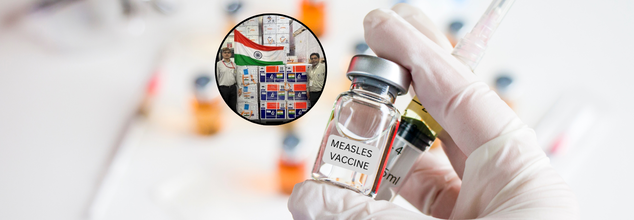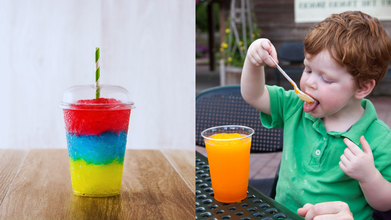- Health Conditions A-Z
- Health & Wellness
- Nutrition
- Fitness
- Health News
- Ayurveda
- Videos
- Medicine A-Z
- Parenting
- Web Stories
'Three-Parent-Baby' Technique: How UK Is Making Healthy Babies With DNA From Three People To Avoid Genetic Mitochondrial Disease

Credits: Canva
Mitochondrial Disease: In a groundbreaking development in reproductive medicine, researchers in the U.K. announced that eight healthy babies have been born using an experimental technique involving DNA from three people.
The method was developed to help prevent mothers from passing on devastating mitochondrial diseases to their children — conditions that can lead to seizures, muscle weakness, organ failure, developmental delays, and even death.
This scientific milestone was detailed in a study published in the New England Journal of Medicine on Wednesday.
Experts from Newcastle University in the U.K. and Monash University in Australia conducted the procedures, which used a technique known as mitochondrial donation treatment. The technique replaces faulty mitochondria, which are the tiny energy-producing structures in cells, with healthy ones from a donor.
What Is Mitochondrial DNA?
While most of our DNA is stored in the nucleus of our cells and inherited equally from both parents, a small but vital portion resides in the mitochondria and comes solely from the mother. Mutations in this mitochondrial DNA can lead to serious, and often fatal, genetic disorders in children.
During the in vitro fertilization (IVF) process, it is sometimes possible to detect these mutations early. However, in rare cases, such mutations go undetected — which is where mitochondrial donation becomes important.
In this method, scientists transfer the nuclear DNA from the mother's egg or embryo into a donor egg or embryo that contains healthy mitochondria but has had its own nuclear DNA removed. The resulting embryo contains nuclear DNA from the parents and mitochondrial DNA from a donor — essentially, the genetic input of three people.
A Scientific First Made Possible by Law
The U.K. became the first country in the world to legalize mitochondrial donation for clinical use in 2016, after years of ethical and scientific debates. Australia has also approved its use. However, the U.S. still prohibits any clinical research involving genetic modification of human embryos that could be inherited.
“This marks an important milestone,” said Dr. Zev Williams, director of the Columbia University Fertility Center in New York, who was not involved in the study. “Expanding the range of reproductive options will empower more couples to pursue safe and healthy pregnancies.”
As of now, 35 couples have been approved by the U.K.’s fertility regulator to undergo the procedure. Of the 22 patients treated in the reported study, eight babies have been born, and one more woman is still pregnant. Most of the children appear to be free of mitochondrial disease, though one child was found to have a slightly higher-than-expected level of abnormal mitochondria. Experts say this level is not currently cause for concern but will require monitoring.
A Tiny Donor Footprint
Despite the involvement of a third person, scientists emphasize that the genetic material from the donor is minimal. Dr. Robin Lovell-Badge, a stem cell expert at the Francis Crick Institute, noted that the donor’s mitochondrial DNA makes up less than 1% of the baby’s total genetic makeup — not enough to influence personal traits like appearance or personality.
“In fact, if you had a bone marrow transplant, you would carry much more of another person’s DNA,” he explained.
Hope for Families, But Questions Remain
The technology remains controversial in some circles. Critics warn that the long-term effects of such genetic manipulation are still unknown and could have unintended consequences for future generations. In the U.S., Congress has repeatedly blocked any government funding or approval of similar research.
Still, for many families, the promise of avoiding a life-threatening diagnosis is worth the risk.
Liz Curtis, whose daughter Lily died of mitochondrial disease in 2006 at just eight months old, now advocates for awareness and research. She founded the Lily Foundation in her daughter's memory and supports the work being done at Newcastle University.
Curtis said the diagnosis devastated her family. “Nobody could tell us what it was or how it would affect Lily. It was just a waiting game,” she recalled. “This new technique gives hope to families who’ve had very little of it.”
As science and ethics continue to evolve, the three-parent baby technique stands as a powerful, if complex, step forward in preventing inherited genetic illness.
India Sends 300,000 Measles Vaccines To Bolivia Amid Rapidly Growing Disease Outbreak

Credits: Canva/ X@MEAIndia
Bolivia is in the middle of a public health emergency. Measles—once thought to be close to eradication in many parts of the world—has returned, with 60 confirmed cases sparking alarm across the country. In response, India dispatched 300,000 doses of the combined Measles and Rubella (MR) vaccine, providing a much-needed boost to Bolivia's immunization drive.
This timely shipment comes as the South American country scrambles to contain the outbreak. The Bolivian government has declared a National Health Emergency, activated emergency protocols, and called on local governments and global partners to ramp up vaccination efforts.
Measles is often underestimated, especially in countries where immunization coverage is high. But here’s the reality: measles is one of the most contagious viruses known to humans. It can cause severe complications—pneumonia, encephalitis, and even death—especially in children under five or those with malnutrition.
Bolivia's Health Minister Maria Renee Castro made it clear: the outbreak could spiral if parents don’t act. “It is essential that parents get their children vaccinated,” she said. Though the country has half a million doses in stock, coverage is falling short. And that’s the bigger issue.
What Triggered The Measles Outbreak In Bolivia?
The current crisis didn’t appear overnight. Like many countries, Bolivia experienced disruptions in routine vaccinations during the COVID-19 pandemic. Combined with misinformation, vaccine hesitancy, and uneven access to healthcare in remote areas, immunization rates dropped to dangerously low levels.
This created fertile ground for the measles virus to resurface. Unlike other diseases that require direct contact, measles is airborne and can linger in the air for hours. Just one infected person can spread it to up to 18 others in an unvaccinated population.
India’s shipment of vaccines is part of a larger diplomatic and public health strategy. Known as the pharmacy of the Global South, India has been supplying vaccines and essential medicines to dozens of countries for decades. During the COVID-19 crisis, its Vaccine Maitri initiative helped over 90 nations.
In Bolivia’s case, the consignment not only supports outbreak response—it also reflects India’s growing role as a global health partner. By responding quickly and decisively, India is showing that vaccine diplomacy can fill the void where traditional global mechanisms may be slower to act.
Bolivia’s response plan now hinges on mass immunization campaigns—especially for children under five. President Luis Arce Catacora urged citizens to fully cooperate with health authorities. “Our duty is clear: to protect our children and the population from a threat that has already raised health alerts across the continent,” he said.
These campaigns will be coordinated across local and regional levels, supported by international organizations and bilateral partners like India. The goal is twofold: contain the outbreak quickly and restore public trust in routine immunizations.
What’s happening in Bolivia is a warning to the rest of the world. The measles virus doesn’t respect borders, and as global travel resumes, so does the risk of transmission. According to the World Health Organization, measles cases and deaths globally rose by 43% in 2022 alone. If global immunization coverage falls below 95%—especially for the two-dose measles vaccine—outbreaks are inevitable.
From Vaccine Access to Outbreak Prevention: The Missing Link
Here’s what this crisis teaches us: access to vaccines alone isn't enough. Countries need resilient health systems that can deliver these vaccines consistently, even in remote areas and during disruptions like a pandemic or natural disaster.
What this really means is that vaccine availability, while crucial, must be paired with last-mile delivery, consistent public messaging, and community trust. Otherwise, even the best stockpile can’t stop a virus that spreads faster than the news of its arrival.
The resurgence of measles in Bolivia isn’t just a regional emergency—it’s a global red flag. If countries let their guard down, diseases that were nearly eliminated will come roaring back. India’s support to Bolivia is a timely reminder that in public health, preparedness is not a choice, it’s a necessity.
Measles is preventable. The vaccine works. The challenge is ensuring it's not just produced and delivered—but also accepted, administered, and trusted. That’s the path to not just containing outbreaks—but ending them for good.
UK Issues Slushie Warning: Why This Summer Favourite Could Be Risky for Kids

Just as British summer hits full swing, the UK’s Food Standards Agency (FSA) has dropped a warning: slushies may not be so child-friendly after all. In an urgent new advisory, the FSA has warned parents to steer clear of giving slush ice drinks to children under seven, especially those containing a chemical called glycerol. And for kids between seven and ten? Keep it to a strict 350 ml a day.
What’s So Dangerous About a Slushie?
Slushies may seem like they beat the heat, but beneath that colour lies a syrupy science experiment. Most commercial slush drinks get their signature texture from glycerol, a compound that keeps ice from freezing into one giant block and gives slushies their semi-liquid, chewable charm. The trouble is, glycerol is harmful when consumed in large quantities, especially by small bodies.
According to the FSA, excessive intake of glycerol in a short span can cause mild symptoms like nausea, headaches and vomiting. But in more severe cases, children can suffer from dangerously low blood sugar, go into shock, or even lose consciousness.
The Risks Are Real and Rising
This warning did not come out of nowhere. The FSA has seen a surge in reports of children collapsing after drinking slushies. In many of these cases, the affected kids had consumed slush drinks in large amounts over a short period.
Summer’s New Parenting Rule
The FSA is urging parents and carers to be vigilant. Before buying a slushie, they recommend asking vendors whether the drink contains glycerol. If you are not sure, play it safe, especially with younger kids. Parents should also keep an eye on home-use slush kits and ready-to-drink slush pouches, which may also include this ingredient.
The shops have now also been instructed to stop offering free slushie refills for children under 10 and to use the minimal amount of glycerol necessary to get that slushy texture.
What to Do If a Slushie Turns Sour
If your child starts feeling queasy or dizzy after downing a slushie, do not panic, but do act. In mild cases, giving them a sugary snack or drink can help stabilise blood sugar levels. But if your child seems lethargic, confused, or unresponsive, call 999 immediately. It is better to be overly cautious than to risk a serious health episode.
Slushie Season, But Make It Safer
This new advice arrives just ahead of the school summer holidays, the peak slushie season in the UK. As temperatures soar, these icy drinks will be everywhere. The message from the FSA is clear: slushies are not forbidden, but they are not harmless either. Especially when they are packed with glycerol and served up to tiny tummies.
Flesh-Eating Bacteria Claims 4 Lives in Florida: What You Should Know

Credits: Canva
Four people in Florida have died from Vibrio vulnificus, a dangerous bacterium often dubbed the "flesh-eating" bacteria, as the state reports a total of 11 infections this summer. The deaths occurred across Hillsborough, Bay, Broward, and St. Johns counties, according to the Florida Department of Health’s latest update released on July 11.
Cases have also been identified in Duval, Escambia, Lee, Manatee, Santa Rosa, and Walton counties. While the numbers might seem small, health officials say the consequences can be devastating if the infection is not caught early.
What Is Vibrio Vulnificus?
Vibrio vulnificus is a naturally occurring bacterium found in warm saltwater or brackish water, which is a mix of salt and freshwater. It thrives particularly well during the hotter months, which is why infections spike from May through October. According to the Centers for Disease Control and Prevention (CDC), the bacteria is halophilic, meaning it needs salt to survive.
While rare, the infection can cause necrotizing fasciitis. It is a condition where flesh-eating bacteria could destroy the tissue under the skin, and can lead to death in just a few days if left untreated.
How People Get Infected?
According to Dr. Norman Beatty, an infectious disease specialist and associate professor at the University of Florida, as reported by WUSF, West Central Florida's NPR station broadcasting news, there are two main ways people typically contract Vibrio vulnificus.
“We can consume it through contaminated shellfish, specifically oysters,” Beatty said. If ingested, the bacteria can cause symptoms like nausea, vomiting, diarrhea, and abdominal cramps.
Also Read: 'Pretty Little Baby' Singer Connie Francis Passes Away At 87, What Happened To Her?
But the more dangerous and more common route, he explains, is through open wounds. “If someone with a cut or scrape enters brackish or saltwater contaminated with Vibrio vulnificus, the bacteria can enter the body through the skin and cause serious infection,” he warned.
Symptoms to Watch For
Symptoms often appear quickly; sometimes within hours of exposure. Early signs include redness, pain, and swelling around the wound. As the infection progresses, it can cause skin ulcers, blisters, and even tissue death. Systemic symptoms like fever, chills, and low blood pressure may also follow.
“A delay in treatment can lead to serious complications, including amputations or even death,” Dr. Beatty cautioned.
Who’s Most at Risk?
People with weakened immune systems, liver disease, or chronic health conditions are at greater risk of developing severe infections. But Dr. Beatty emphasized that even healthy individuals aren’t immune.
“I’ve seen otherwise healthy people who got a small cut while fishing or kayaking and ended up battling this infection,” he said.
How to Stay Safe?
With summer in full swing and more people spending time in and around water, doctors urge caution. If you have an open wound, avoid wading or swimming in warm seawater or brackish water. If exposure happens accidentally, clean the wound immediately with soap and bottled water. Covering healing wounds with waterproof bandages can also reduce the risk of infection.
If symptoms develop after being in such water or consuming raw seafood, particularly oysters, seek medical attention immediately and inform the doctor of your recent exposure.
A Persistent Health Threat
WUSF reports that in 2024 alone, Florida reported 82 Vibrio vulnificus cases and 19 deaths. Some of those were tied to flooding from Hurricane Helene, which caused contaminated water to spread inland. In past years, spikes in infections have been linked to major storms and hurricanes, including Hurricane Ian in 2022.
The CDC estimates around 80,000 Vibrio-related illnesses occur in the U.S. each year, with about 100 deaths, many of them preventable with timely care.
As Dr. Beatty puts it, “This is not a bacteria to take lightly. With increased awareness and a bit of caution, we can lower the risk and save lives.”
© 2024 Bennett, Coleman & Company Limited

